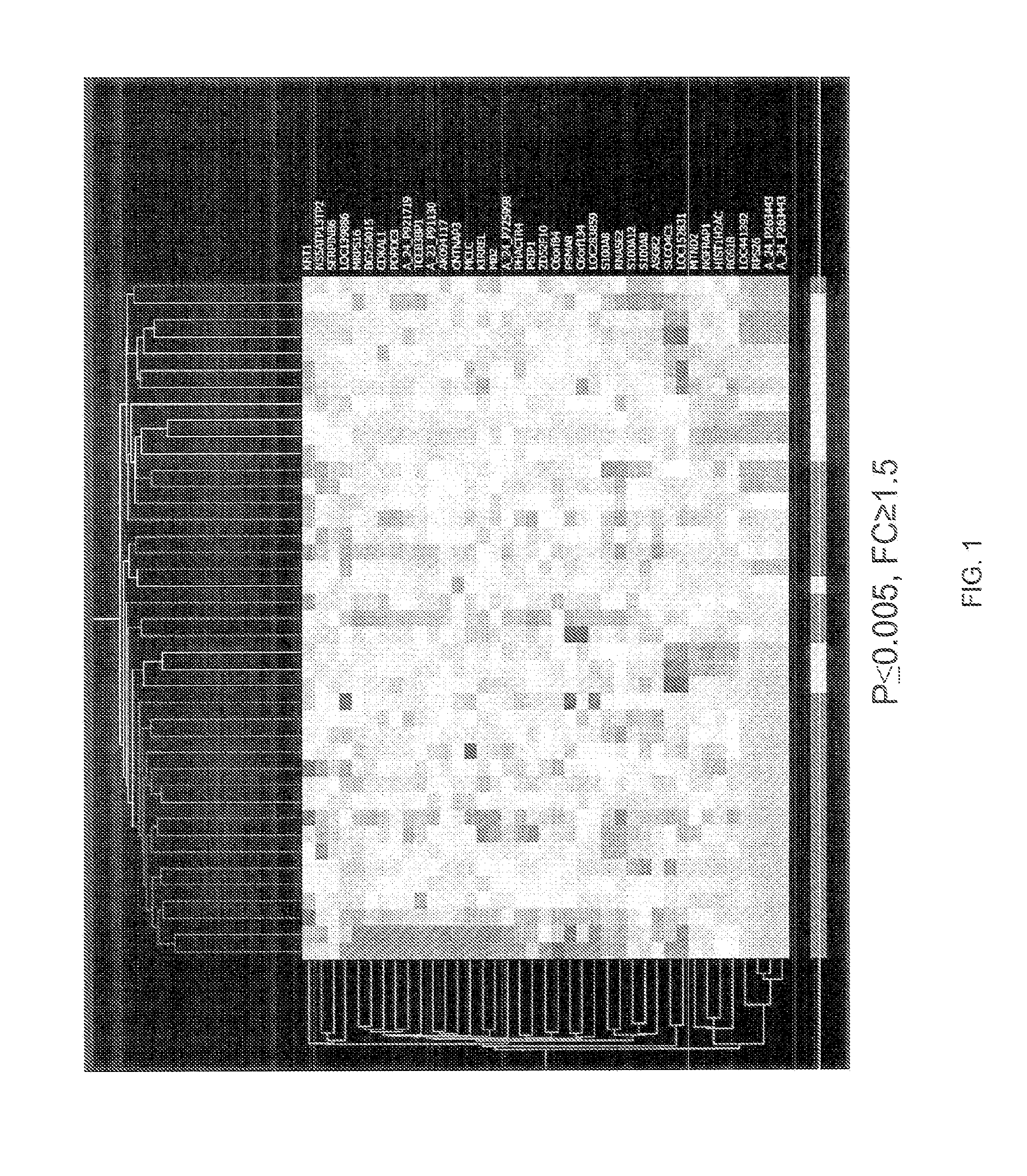Predictive models and methods for diagnosing and assessing coronary artery disease
a technology of predictive models and methods, applied in the direction of instruments, analogue processes for specific applications, electric/magnetic computing, etc., can solve problems such as tissue injury, chest pain, and potential life-threatening acute coronary syndrom
- Summary
- Abstract
- Description
- Claims
- Application Information
AI Technical Summary
Benefits of technology
Problems solved by technology
Method used
Image
Examples
example 1
General Procedures Used to Identify and Validate Candidate Genes
[0061]Multiple approaches were used to identify and confirm the consistency of gene expression data for candidate genes whose expression pattern in peripheral blood cells may be correlated with the various stages of CAD. Gene expression measurements were made using RNA extracted from human blood samples. Two approaches were used: microarray analysis using a Whole Genome Chip (44K) available from Agilent Technologies, Inc., Santa Clara, Calif. in accordance with the manufacturer's instructions, and real time polymerase chain reaction (RT-PCR) analysis carried out on a model 7900 Fast Real-Time PCR instrument available from an Applied Biosystems, Inc., Foster City, Calif. used in accordance with the manufacturer's instructions. Candidate genes are those genes that are differentially expressed in patients having established CAD as compared to disease-free controls. An extensive literature search was also completed to ident...
example 2
Identification of Candidate Genes from a First Cohort via Whole Genome Microarray Analysis
[0064]Samples were selected from a first cohort of patient samples. These patients had undergone cardiac catheterization and peripheral blood leukocyte samples from these patients had been prepared for RNA extraction. All samples were collected in CPT™ cell preparation tubes containing sodium citrate and total RNA was purified from the peripheral blood mononuclear cells. The samples represented various stages of CAD including: cases with single and multi-vessel disease and stable angina; single and multi-vessel disease and unstable angina and control subjects with no angiographic evidence of CAD. The clinical characteristics of this first cohort are found in Table 2.
[0065]Two microarray experiments were performed using the microarray chip described in Example 1.
Array 1 Pilot Study
[0066]For the first microarray experiment, the samples selected from the first cohort were classified as either unst...
example 3
Pilot RT-PCR Experiment
[0092]RT-PCR studies were undertaken to determine the validity of the genes identified from the microarray analysis. The RT-PCR studies were completed on two ABI 7900 Real Time PCR systems using the default 40 cycle program. Data was exported using an ABI baseline setting at 0.2 and a background subtraction of cycles 3 through 15.
[0093]The first study was a pilot RT-PCR study to determine the false discovery rate (FDR) from both of the array experiments. 27 genes were selected from Array 1 for this pilot study: the initial 10 test were selected at random while the subsequent 17 were selected based on the lowest p values. Of these 27 genes, 16 had p values of ≦0.15 and were included in the set of 30 genes from Array 1 which would be included in the initial RT-PCR screening, with the remaining 14 genes being selected from genes showing lower p values on the array.
[0094]A similar strategy was employed for genes selected from Array 2 for the pilot study. Ten genes...
PUM
| Property | Measurement | Unit |
|---|---|---|
| Gene expression profile | aaaaa | aaaaa |
| Level | aaaaa | aaaaa |
Abstract
Description
Claims
Application Information
 Login to View More
Login to View More - R&D
- Intellectual Property
- Life Sciences
- Materials
- Tech Scout
- Unparalleled Data Quality
- Higher Quality Content
- 60% Fewer Hallucinations
Browse by: Latest US Patents, China's latest patents, Technical Efficacy Thesaurus, Application Domain, Technology Topic, Popular Technical Reports.
© 2025 PatSnap. All rights reserved.Legal|Privacy policy|Modern Slavery Act Transparency Statement|Sitemap|About US| Contact US: help@patsnap.com



